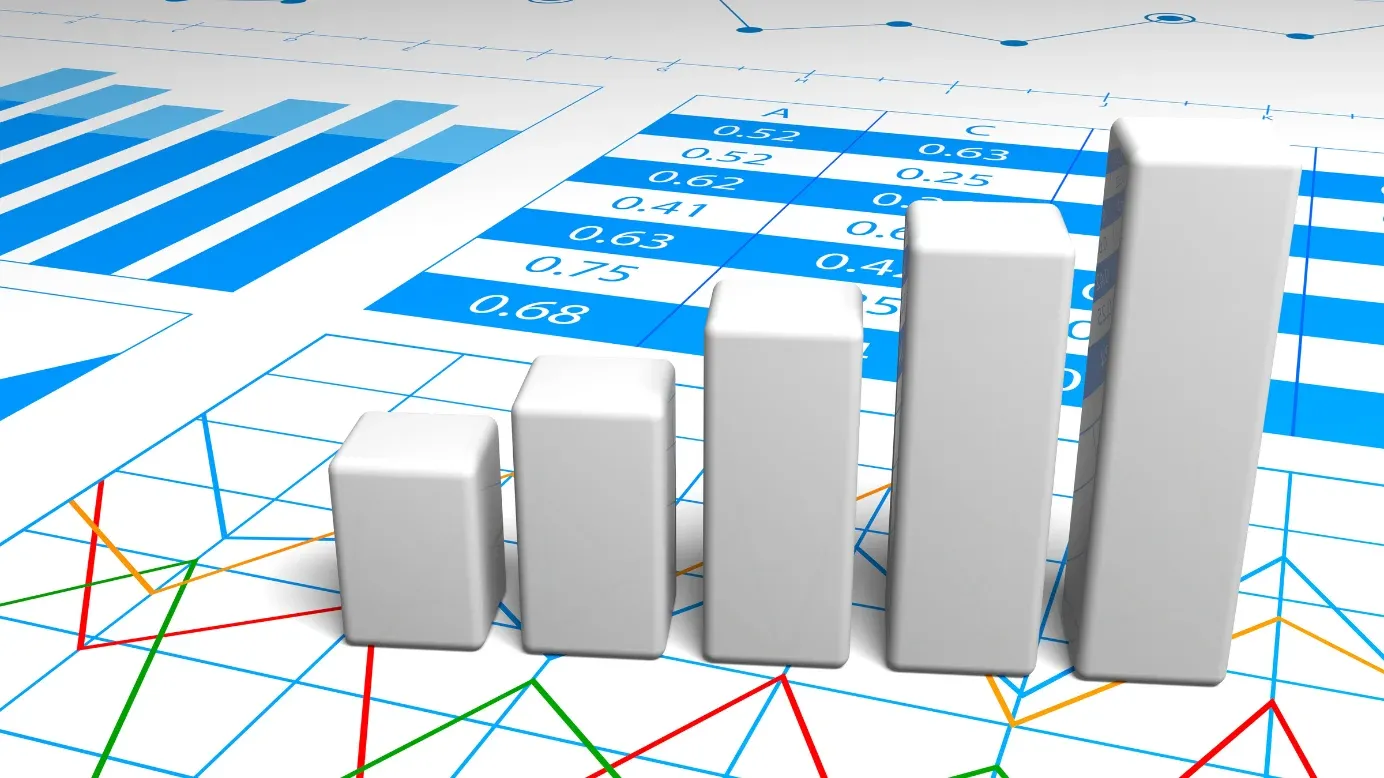Satu-satunya Panduan Perkiraan Penjualan yang Anda Butuhkan untuk Menguasai Seni Prediksi
Peramalan penjualan adalah memperkirakan penjualan produk atau layanan di masa depan. Perkiraan penjualan membantu menetapkan pertumbuhan penjualan jangka panjang, perencanaan pendapatan, proyeksi arus kas, dan kebutuhan sumber daya.
Di halaman ini
Sales forecasting, in simple terms, is the process of revenue estimation by predicting how much a sales unit can sell a product or service in the upcoming week, month, quarter, or year.
When it comes to one of the most important numbers to a business, the sales forecast sits at the top dictating other variables related to marketing, hiring, prospecting, and even product development.
Accurate sales forecasting is both an art and a science, and getting it right is a tough task even seasoned salespeople struggle with as Gartner reports only 45% of sales leaders have high confidence in forecasting the accuracy of their organization. So, what goes into sales forecasting, and why is it tricky? This article explores.
Apa yang dimaksud dengan perkiraan penjualan?
When businesses produce a sales forecast, they estimate the figure of what they expect the sales revenue to look like. It estimates how much of the product or service they can sell in a period of time, such as a month, quarter, or year.
Some of the best sales forecasts can predict revenue with a good degree of accuracy depending on the inputs and the time frame of the prediction.
Similar to how minimum advertised price tracking allows companies to keep a finger on the pulse and adjust to changes in the market, an accurate sales forecast provides valuable insights because it is based on historical data.
Sales forecasts are generally made using data from previous performances, and the sales forecasting techniques differ based on the inputs. For example, the forecast might be made based on the intuition of the sales rep or using data and trends fed into artificial intelligence.
Sales forecasts made by sales reps are used by managers to estimate the business the team brings. Forecast data from teams are used by the directors to anticipate sales by the department and the VP of sales uses collective data from the departments to project organizational sales.
Prakiraan penjualan menjawab dua pertanyaan bisnis yang penting-
- Berapa banyak yang Anda harapkan untuk dijual?
- Dan dalam jangka waktu berapa lama?
Setiap peluang penjualan memiliki jumlah yang diproyeksikan sebagai potensi bisnis bagi perusahaan dan tim penjualan harus menghasilkan angka realistis yang mewakili bisnis baru dan kerangka waktunya.
Menjawab dua pertanyaan tersebut membantu organisasi menetapkan tujuan dan membuat rencana strategi penjualan.
Why do we need sales forecasting?
Peramalan menciptakan titik referensi untuk masa depan yang dapat diandalkan perusahaan untuk membuat keputusan bisnis yang penting. Perkiraan yang akurat juga menjadikan perusahaan sebagai pemimpin pasar dan memberikan kredibilitas dalam industri. Berikut adalah beberapa cara perkiraan penjualan memengaruhi fungsi perusahaan:
1. Pengambilan keputusan strategis
Sales forecasting can reveal emerging trends and prompt decision-makers to rectify a problem or capitalize on a foreseeable opportunity. For example, a 30% negative deviation from the sales target might uncover poor management or underperforming sales units or even indicate competitors upping their game.
On the other hand, a positive deviation would indicate the need to recruit more resources to capitalize on the opportunity. Forecasting sets the baseline, which aids in timely action and course correction.
2. Memetakan jalan ke depan
Prakiraan menjadi sangat berguna terutama pada saat kinerja yang kurang baik. Hal ini memungkinkan para pengambil keputusan untuk menarik garis yang lebih jelas dan menetapkan tujuan yang lebih baik untuk mengurangi kerusakan dan bahkan memotivasi tim melalui tonggak pencapaian dan rencana aksi.
3. Pengambilan keputusan keuangan
Peramalan penjualan yang akurat memainkan peran penting dalam berbagai latihan pemodelan keuangan. Mereka menentukan:
- Persediaan: Perkiraan penjualan yang akurat dibuat melalui asumsi yang tepat mengenai kebiasaan pembelian konsumen atau kenaikan atau penurunan permintaan musiman. Perkiraan ini membantu dalam perencanaan dan manajemen inventaris, yang berkontribusi pada pemanfaatan modal kerja yang efisien. Efisiensi ini kemudian meluas ke perencanaan dan perekrutan bahan baku yang lebih baik.
- Cash Flows: Cash flows are directly affected by sales revenue. Accurate sales forecasting can help model cash movements that allow companies to plan for any shortfalls or windfalls in the future.
Seperti apa perkiraan penjualan yang baik?
A good sales forecast is highly accurate and easily understandable by different stakeholders. It is also well-balanced against time, effort, and the costs associated with the forecasting technique.
Ideally, an accurate forecast model should be built with reliable economic methods. The forecast model should use an algorithm finely tuned to the business and pick relevant data with little manual intervention to make accurate predictions.
However, realistic forecasts are more subjective and time-consuming. Other than the existing numbers, it becomes important to factor in the sales rep’s assessment of future performance.
These perceptions can vary significantly from one sales rep to another, depending on their approach and experience.
For example, a seasoned rep’s 50% sales estimate might be an understatement compared to a different rep’s 60% estimate, which might be overly optimistic.
Siapa yang bertanggung jawab untuk membuat prakiraan penjualan?
Each organization has its own set of forecast owners depending on the type of business and the hierarchies. Typically, the people who make sales forecasts are:
- Sales reps: The people who do the actual selling know their customers and the target market. They are able to set reliable estimates for how much they can sell in a week or month, or quarter based on the market conditions.
- Sales Leaders: The sales leaders pick the numbers from their individual units and make an estimate for their higher-ups. The forecasts can vary based on their seniority - third-line managers, for example, typically consider a wider set of numbers and previous trends in close rates to come up with a forecast, while first-line managers consider opportunities to make their forecasts.
- Product Leaders: Product leaders base sales estimates on what product is available for selling and the time frame for its release.
Sales forecast approaches
Ada dua pendekatan utama untuk perkiraan penjualan:
1. Pendekatan dari atas ke bawah
In the top-down approach, sales forecasting starts with the bigger picture and works downward to define the milestones needed to reach the target.
With such a large estimation, there’s much scope for rushed and ill-defined judgments that can lead to unrealistic expectations. However, the approach is useful for quickly establishing optimistic organization-wide benchmarks in established companies.
2. Pendekatan dari bawah ke atas
The bottom-up approach is a conservative and granular approach that takes into account the resources held by the company.
The bottom-up approach takes a practical look at the efficiency of the business and figures out the variables which can be tweaked to increase sales. This approach relies heavily on existing data to create a more structured and realistic perspective for sales forecasting purposes.
Sales forecasting methods
Metode peramalan penjualan dapat dibagi menjadi metode Kualitatif dan Kuantitatif. Metode kualitatif bergantung pada penilaian subjektif dari tenaga penjualan dan pengambil keputusan, sedangkan metode kuantitatif bergantung pada data, angka, dan pemodelan statistik.
1. Qualitative sales forecasting
Qualitative sales forecasting often uses 5 major methods. These methods are based on informed opinions about the markets, trends, and prospects. The surveys involved are often time-consuming and expensive. The top 5 methods include:
- The panel method or jury of executive opinion method: As the name suggests, the approach involves executive groups discussing sales predictions to reach a consensus. One of the main advantages of the method is that experienced members of the jury can bring in plenty of wisdom to the predictions. The same can also be a disadvantage as bad predictions can be made by dominant members of the jury with biased views.
- Delphi method: The Delphi method is iterative in nature and involves surveying each expert independently. The output is then shown to the experts so their responses can be reconsidered in light of the broader consensus. The approach is an antidote to the groupthink that can dominate a jury approach.
- Customer surveys: In this method, prospects or a sample of the customers are surveyed about their purchase plans in the short and long terms. For larger markets, various survey methods can be employed to determine a generic trend.
- Sales force composite method: This method forecasts sales by pooling the collective numbers of forecasts of individual sales reps. These numbers are then reviewed by the heads and sales managers along with product owners to make distilled forecasts. While the approach has its merits, it also doesn’t take factors such as new trends, regulatory changes, and product innovation into the picture.
- Scenario planning: Scenario planning is an all-encompassing approach that doesn’t come up with a single accepted forecast. Instead, it models different scenarios to let companies prepare for uncertain sales outcomes. This method is used for estimates sales over a long period of time, such as three years or more. Under scenario planning, variables such as recessions, disruptive technologies, changes in prices, and other things that affect sales are brainstormed.
2. Quantitative sales forecasting
Peramalan penjualan kuantitatif menggunakan data dan pemodelan statistik untuk memprediksi penjualan dalam skala waktu yang berbeda. Berikut adalah dua metode yang paling umum digunakan:
- Time series method: The approach works under the assumption that sales trends historically repeat over seasons and sales cycles. Hence it uses historical, chronologically ordered data to make sales forecasts. Future sales are calculated by historical sales multiplied by the growth rate. Some of the popular techniques include exponential smoothening, moving averages, ARIMA, and X11.
- Casual method: In this method, the historical cause and effect between sales and market variables are taken into account for forecasting. With the casual method all possible variables that can affect sales are modeled to make accurate forecasts for the future. The variables include factors such as customer sentiment, third-party surveys, macroeconomic trends, and internal sales results. Popular casual techniques include linear or multiple regression, leading indicators, and econometric approaches.
Sales forecasting examples
Berikut adalah dua contoh prakiraan penjualan untuk metode prakiraan penjualan kualitatif dan kuantitatif:
1. Metode intuitif (Kualitatif)
The intuitive method is the simplest of the qualitative methods for sales forecasting. The approach relies strongly on the performance and experience of sales reps in closing deals and their track record of matching up to expectations.
The method is quite helpful if there’s no historical data to make a forecast for the month or quarter. Instead, the “intuition” or the “gut feeling” of the sales reps based on their initial contact with the prospect is used to determine how much sales can be done.
The sales manager asks for an estimate from four sales reps for the quarterly sales. Sales rep 1, who is the top performer, estimates $200,000. Sales rep 2, who is a close performer to the former, makes an estimation of $180,000.
Sales rep 3, who has two years of experience, estimates his sales to be around $120,000, while Sales Rep 4 who is a recent college graduate, gives an estimate of $110,000. Summing up the forecasts gives an intuitive forecast of $610,000 in sales for the quarter.
However, upon close inspection, it is discovered that Sale Rep 4 has an optimistic exaggerated forecast because of his inexperience. His realistic number is closer to $60,000 in sales. Therefore, the revised quarterly sales would be about $560,000.
2. Metode Historis (Kuantitatif)
As discussed earlier, the historical method is an example of the time-series forecasting technique, which uses historical data to make future predictions.
To account for the variables such as growth, inflation, fluctuations in demand, and other variables, an estimated growth rate is multiplied by the historical sales to arrive at the future forecast.
How to design a sales forecasting plan?
Peramalan penjualan membutuhkan dasar yang kuat dari teknik matematika dan pengetahuan rinci tentang siklus penjualan yang umum. Ditambah dengan data yang relevan, langkah-langkah berikut ini dapat digunakan untuk merancang rencana prakiraan penjualan:
1. Memilih metode perkiraan
Data dari penjualan masa lalu dan model prakiraan sangat penting untuk membangun model baru untuk masa depan. Sejumlah teknik prakiraan penjualan yang lebih sederhana, seperti prakiraan tahap peluang, prakiraan historis, prakiraan panjang siklus, dan lain-lain, dapat digunakan untuk membuat prakiraan yang dapat diandalkan. Perkiraan dengan presisi yang lebih tinggi dapat dibuat dengan model yang lebih intensif data seperti regresi berganda dan penghalusan eksponensial.
2. Menentukan waktu perkiraan
Jenis rencana tergantung pada apakah perkiraan dibuat untuk jangka waktu tertentu seperti bulanan atau triwulanan, atau apakah penjualan dilacak untuk output tertentu saja. Faktor musiman, seperti rilis selama kuartal tertentu, juga dapat memengaruhi prakiraan. Oleh karena itu, kuartal tersebut mungkin harus dilihat secara berbeda.
3. Perincian siklus penjualan
Jangka waktu dari setiap penjualan memiliki pengaruh pada perkiraan penjualan. Dengan menguraikan siklus penjualan menjadi waktu rata-rata yang dihabiskan untuk setiap tahap, maka dimungkinkan untuk menentukan panjang rata-rata siklus penjualan.
4. Memanfaatkan tren metrik penjualan
Dengan menggunakan data historis terbaru, variabel seperti harga penjualan rata-rata dan persentase tingkat pembaruan dapat ditentukan untuk perkiraan baru. Variabel lain seperti tingkat konversi, tingkat perputaran, lintasan pertumbuhan rata-rata, dan pendapatan berulang tahunan (ARR) juga harus dimasukkan ke dalam perkiraan.
5. Membuat templat prakiraan
Generate a template based on the sales cycle, objectives, metrics, and specifics of the sales teams. Smaller companies with limited resources can use a tool like Microsoft Excel when there are fewer products to track.
Larger organizations with automated tools that connect to the CRM can utilize the features of automation to make estimates. For instance, lead enrichment software can predict when a prospect is on the verge of conversion. This data can be used to make highly accurate forecasts for different sales cycles.
6. Bagikan dokumen resmi dengan tim
Dokumentasi formal diperlukan untuk membagikan rencana tersebut dengan tim dengan transparansi penuh. Sangat penting bagi perwakilan penjualan untuk memahami bagaimana prakiraan dibuat, sehingga mereka memiliki pemahaman yang kuat tentang tujuan dan kuota mereka.
How to accurately forecast sales?
Perkiraan penjualan yang akurat merupakan keseimbangan yang rumit dalam menggabungkan tren historis, perubahan internal, fluktuasi pasar, dan tekanan pesaing. Berikut adalah 5 langkah yang mengarah pada akurasi dalam prediksi:
1. Penilaian tren historis
Untuk membuat dasar perkiraan penjualan, penting untuk membuat 'tingkat penjualan', yang merupakan proyeksi penjualan untuk periode penjualan. Data historis dari tahun sebelumnya dapat dipisahkan menurut harga, produk, tenaga penjualan, periode penjualan, dan variabel lainnya untuk membuat tingkat penjualan untuk prakiraan.
2. Memasukkan perubahan
Tingkat penjualan perlu dimodifikasi berdasarkan beberapa variabel, seperti harga, promosi, saluran, pelanggan, dan perubahan produk. Variabel-variabel ini memberikan tingkat penjualan yang lebih realistis untuk periode penjualan.
3. Antisipasi tren pasar
Tren pasar, seperti perubahan perilaku pesaing, perubahan legislatif, merger perusahaan, dan lain-lain, dapat menimbulkan bola kurva pada saat yang tidak terduga. Penting untuk memperhitungkan perubahan ini untuk membuat model prakiraan jika terjadi pergeseran tren pasar.
4. Pemantauan persaingan
Sangat penting untuk memantau persaingan untuk mengetahui dampaknya terhadap target pasar dengan tindakan seperti variasi harga, peluncuran fitur baru, atau kampanye baru. Persaingan baru juga harus dipantau untuk mengetahui dampaknya terhadap pangsa pasar.
5. Termasuk rencana bisnis
Business strategic plans that have an effect on growth, hiring, targeting new markets or kicking off new campaigns can all have an impact on future sales. Therefore, it is important to make forecasts while keeping sight of business plans.
How Compass can help with sales forecasting

Compass provides valuable tools—Simulation and Estimator—that enhance the accuracy and efficiency of sales forecasting by offering data-driven insights into commissions, performance, and potential earnings. Here’s how:
1. Optimizing commission plans through simulation
Compass allows admins to simulate different commission structures, adjusting rewards, milestones, and metric logic. This helps in evaluating how changes impact sales performance, leading to a more accurate sales forecast.
2. Understanding earnings from pipeline opportunities
The Estimator tool provides salespeople with insights into their potential earnings from pipeline deals. This visibility helps in sales forecasting, allowing teams to plan better and stay motivated to close deals.
3. Enhancing revenue predictability
By testing and refining commission strategies, businesses can improve their sales forecasting accuracy with Compass. Identifying trends and performance patterns ensures a more reliable sales forecast and supports data-driven decision-making.
4. Driving performance with informed adjustments
Sales leaders can use simulation insights to make informed adjustments to incentive plans. This not only improves team motivation but also strengthens sales forecasting, making it easier to set realistic sales targets.
With Compass, you can fine-tune your commission plans, maximize sales performance, and achieve more accurate sales forecasting. Start using Compass to optimize your revenue strategy now!
Tantangan utama dalam prakiraan penjualan
Menghasilkan prakiraan yang akurat secara konsisten dapat menjadi tantangan bagi organisasi. Berikut ini adalah beberapa rintangan utama yang dihadapi oleh sebagian besar perusahaan:
- Accuracy: Companies, especially startups who are bootstrapping tend to rely on spreadsheets for forecasting, which can introduce huge accuracy issues to the forecasts. Even companies with CRMs struggle with poor adoption across the company, with employees not entering data on time, data silos, incomplete data, and inaccuracies.
- Subjectivity of forecasts: While forecast quality does depend on good decisions and judgment when predictive analysis takes a backseat to the subjective analysis, it can miss real drivers of accuracy.
- Universality: Sales forecasts that are not useful for stakeholders across the company are ineffective in producing results. Good forecasts always have relevant and understandable data for different teams across the company.
- Inefficiency: Inefficiency can often make it into forecasts when there are multiple owners, varied inputs that remain unreconciled, and too many revisions and different versions.
Perkiraan penjualan selama waktu yang tidak terduga
Waktu yang tidak dapat diprediksi adalah peristiwa seperti bencana besar, krisis seperti pandemi COVID, atau gejolak ekonomi yang tiba-tiba. Peristiwa-peristiwa ini dapat secara tiba-tiba membalikkan perkiraan penjualan. Segera setelah salah satu dari peristiwa ini terjadi, penting bagi para pemimpin bisnis untuk mengetahui hal-hal berikut ini:
- Kondisi saluran penjualan saat ini
- Skenario terbaik dan terburuk yang dimodelkan
- Seberapa besar perubahan prakiraan selama seminggu atau sebulan
A real-time view of the sales pipeline is critical in such situations to make an instant business decision that can minimize the damage from a disruptive event.
The CRM solution and automation are what would cushion an inevitable blow to the forecasts. Reliable instantaneous data is what would help business leaders to pivot territories and resource deployment that can have a strong bearing on the continuity or dissolution of the business.
Pikiran penutup
Making an accurate sales forecast is both an art and a science that combines the well-developed intuition of an experienced salesperson and reliable data fed into forecasting algorithms.
While it is essential that sales teams have the skills to make good forecasts relying on simple spreadsheets and back-of-the-napkin calculation methods, reliable forecasts need software solutions that can give real-time insights and projections based on data. Take Compass as an example.
By testing and refining commission strategies, businesses can improve their sales forecasting accuracy. Identifying trends and performance patterns ensures a more reliable sales forecast and supports data-driven decision-making. Schedule a call to know more!
Pertanyaan Umum
1. What is sales forecasting?
Sales forecasting is the process of estimating future sales based on historical data, market trends, and current pipeline opportunities. It helps businesses predict revenue and plan resources effectively. A sales forecast is essential for setting sales targets, budgeting, and making strategic decisions.
2. What are the four major sales forecasting techniques?
The four major sales forecasting techniques include:
- Historical Data Analysis – Uses past sales trends to estimate future sales.
- Opportunity Stage Forecasting – Evaluates deals in the sales pipeline to predict revenue.
- Market Research Forecasting – Leverages industry trends and customer demand analysis.
- Regression Analysis – Uses statistical models to predict future sales based on various factors.
3. What is an example of a sales forecast?
A simple sales forecast might estimate that a company will generate $500,000 in revenue next quarter based on past sales performance and current deals in the pipeline. For instance, if an estimator shows that 70% of opportunities in the pipeline are likely to close, sales teams can use that data to refine their sales forecasting efforts.
4. How to calculate a sales forecast?
A sales forecast can be calculated using this basic formula:
Sales Forecast=Total Opportunities×Win Rate×Average Deal Value\text {Sales Forecast} = \text {Total Opportunities} \times \text {Win Rate} \times \text {Average Deal Value} Sales Forecast=Total Opportunities×Win Rate×Average Deal Value
For example, if a company has 100 sales opportunities, a 30%-win rate, and an average deal value of $5,000, the sales forecast would be:
100×0.30×5000=150,000100 \times 0.30 \times 5000 = 150,000100×0.30×5000=150,000
This helps salespeople estimate their potential earnings and make data-driven decisions.
5. How to create a sales forecast?
To create a sales forecast, follow these steps:
- Analyze past sales data – Look at historical sales trends to identify patterns.
- Evaluate current pipeline opportunities – Use an estimator to assess potential deals.
- Set sales assumptions – Consider market conditions, pricing changes, and competition.
- Choose a forecasting method – Use historical analysis, opportunity-based forecasting, or statistical modeling.
- Monitor and update – Regularly refine the sales forecast based on real-time sales data.
Creating an accurate sales forecasting process ensures businesses can predict revenue, allocate resources wisely, and help salespeople understand how much they can earn from their pipeline opportunities.













